
Aragonite is a fascinating mineral with a unique crystal structure and a rich history. Found in various parts of the world, this mineral is often mistaken for calcite due to their similar chemical compositions. However, aragonite stands out with its distinct orthorhombic crystals. Did you know that aragonite plays a crucial role in marine ecosystems? It forms the skeletons of many marine organisms, including corals and mollusks. Beyond its natural beauty, aragonite has practical uses too. It's used in aquariums to maintain pH levels and in agriculture to improve soil quality. Intrigued by aragonite's versatility? Let's dive into 50 amazing facts about this remarkable mineral that will leave you in awe of its many wonders.
Key Takeaways:
- Aragonite, a unique mineral with diverse uses, is crucial for marine life and environmental balance. It's found in shells, caves, and even hot springs, and can stabilize pH levels in water.
- From aquariums to agriculture, aragonite has practical applications. It's used in water filtration, as a gemstone, and even in the production of cement. Its unique properties make it valuable in various fields.
What is Aragonite?
Aragonite is a fascinating mineral that often gets overlooked. It’s a form of calcium carbonate, just like calcite, but with a different crystal structure. Here are some intriguing facts about this unique mineral.
- Aragonite is named after Molina de Aragón in Spain, where it was first discovered.
- It has the same chemical formula as calcite (CaCO3) but a different crystal structure.
- Aragonite crystals are typically needle-like and can form in clusters.
- This mineral can be found in various colors, including white, blue, green, and brown.
- It forms naturally in mollusk shells and coral skeletons.
- Aragonite is less stable than calcite and can transform into calcite over time.
- It has a hardness of 3.5 to 4 on the Mohs scale.
- Aragonite has a specific gravity of 2.95.
- It is often found in sedimentary rock formations.
- This mineral can also form in hot springs and caves.
Uses of Aragonite
Aragonite isn't just a pretty mineral; it has practical applications too. From aquariums to agriculture, its uses are diverse and beneficial.
- Aragonite sand is used in aquariums to maintain pH levels.
- It is used in agriculture to neutralize acidic soils.
- Aragonite can be used as a gemstone in jewelry.
- It is sometimes used in the production of cement.
- This mineral is used in water filtration systems.
- Aragonite is also used in the manufacturing of glass.
- It can be used as a filler in plastics and paper.
- Some artists use aragonite in sculptures and other artworks.
- It is used in the pharmaceutical industry as a calcium supplement.
- Aragonite is also used in the production of lime.
Where is Aragonite Found?
Aragonite can be found in various locations around the world. Its presence is often linked to specific geological conditions.
- Spain is one of the primary sources of aragonite.
- It is also found in the United States, particularly in New Mexico and Arizona.
- Aragonite can be found in the Bahamas, where it forms in marine environments.
- It is present in the hot springs of Yellowstone National Park.
- This mineral is found in the caves of Mexico.
- Aragonite can be found in the coral reefs of the Pacific Ocean.
- It is also present in the shells of marine organisms worldwide.
- Some deposits are found in the sedimentary rocks of Italy.
- Aragonite is also found in the limestone caves of Slovenia.
- It can be found in the hydrothermal vents of the ocean floor.
Unique Properties of Aragonite
Aragonite has some unique properties that set it apart from other minerals. These properties make it valuable in various fields.
- Aragonite has a higher density than calcite.
- It can fluoresce under ultraviolet light.
- This mineral has a distinct crystal habit, often forming in acicular (needle-like) shapes.
- Aragonite can form in biogenic, sedimentary, and metamorphic environments.
- It has a vitreous to resinous luster.
- Aragonite can exhibit double refraction, where objects viewed through it appear doubled.
- It is more soluble in water than calcite.
- This mineral can form pseudomorphs, where it replaces another mineral while retaining the original shape.
- Aragonite can also form in fibrous, columnar, and stalactitic habits.
- It has a unique ability to stabilize pH levels in water.
Environmental Impact of Aragonite
Aragonite plays a significant role in the environment, particularly in marine ecosystems. Its impact is both beneficial and concerning.
- Aragonite is crucial for the formation of coral reefs.
- It helps marine organisms build their shells and skeletons.
- Ocean acidification can reduce the availability of aragonite, affecting marine life.
- Aragonite deposits can act as carbon sinks, helping to reduce atmospheric CO2.
- It is used in environmental remediation to neutralize acidic waters.
- Aragonite can help restore damaged coral reefs.
- It is involved in the biogeochemical cycling of carbon.
- This mineral can be used to treat wastewater.
- Aragonite sand can help prevent beach erosion.
- It plays a role in the natural purification of water in aquifers.
The Fascinating World of Aragonite
Aragonite, a unique mineral, has captivated scientists and collectors alike. Its stunning crystal formations and diverse applications make it a subject of endless curiosity. From its role in marine ecosystems to its use in jewelry and industry, aragonite proves its worth in various fields. Understanding its properties helps us appreciate the natural processes that create such beauty.
Whether you're a geology enthusiast or just someone who loves learning new things, aragonite offers a treasure trove of knowledge. Its presence in everyday items and its importance in scientific research highlight its versatility. Next time you see a piece of aragonite, remember the fascinating facts behind this remarkable mineral. Keep exploring and stay curious—there's always more to learn about the world around us.
Frequently Asked Questions
Was this page helpful?
Our commitment to delivering trustworthy and engaging content is at the heart of what we do. Each fact on our site is contributed by real users like you, bringing a wealth of diverse insights and information. To ensure the highest standards of accuracy and reliability, our dedicated editors meticulously review each submission. This process guarantees that the facts we share are not only fascinating but also credible. Trust in our commitment to quality and authenticity as you explore and learn with us.


